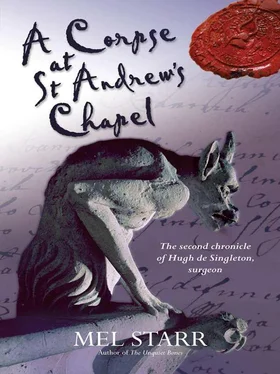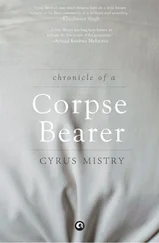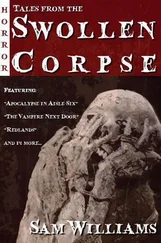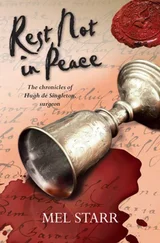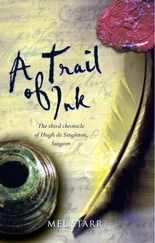Mel Starr - A Corpse at St Andrew's Chapel
Здесь есть возможность читать онлайн «Mel Starr - A Corpse at St Andrew's Chapel» весь текст электронной книги совершенно бесплатно (целиком полную версию без сокращений). В некоторых случаях можно слушать аудио, скачать через торрент в формате fb2 и присутствует краткое содержание. Год выпуска: 2010, Издательство: Kregel Publications, Жанр: Исторический детектив, на английском языке. Описание произведения, (предисловие) а так же отзывы посетителей доступны на портале библиотеки ЛибКат.
- Название:A Corpse at St Andrew's Chapel
- Автор:
- Издательство:Kregel Publications
- Жанр:
- Год:2010
- ISBN:нет данных
- Рейтинг книги:5 / 5. Голосов: 1
-
Избранное:Добавить в избранное
- Отзывы:
-
Ваша оценка:
- 100
- 1
- 2
- 3
- 4
- 5
A Corpse at St Andrew's Chapel: краткое содержание, описание и аннотация
Предлагаем к чтению аннотацию, описание, краткое содержание или предисловие (зависит от того, что написал сам автор книги «A Corpse at St Andrew's Chapel»). Если вы не нашли необходимую информацию о книге — напишите в комментариях, мы постараемся отыскать её.
A Corpse at St Andrew's Chapel — читать онлайн бесплатно полную книгу (весь текст) целиком
Ниже представлен текст книги, разбитый по страницам. Система сохранения места последней прочитанной страницы, позволяет с удобством читать онлайн бесплатно книгу «A Corpse at St Andrew's Chapel», без необходимости каждый раз заново искать на чём Вы остановились. Поставьте закладку, и сможете в любой момент перейти на страницу, на которой закончили чтение.
Интервал:
Закладка:
I adjusted the dagger in my belt, secure in its new sheath, dropped the cudgel from the wall, then followed it down the rope. Once on the ground I sat at the base of the wall to watch and listen for movement. I neither saw nor heard anything but what is common to a summer evening. I paid special attention to the Ladywell. If any supplicant was there he was silent and took no notice of me.
No one, not even John Prudhomme, must know I was about this night. I avoided the town and circled to the north. This doubled the length of my journey, for the castle is on the west edge of Bampton, while St Andrew’s Chapel lies near half a mile to the east of the town.
I stole across the meadow between the castle and the Ladywell, then made my way along a hedgerow north of the millpond until I came to Shill Brook. I removed my boots, waded the stream, and stumbled across a fallow field to the west of the Church of St Beornwald. The night was so dark I nearly missed Laundell’s Lane, but this reassured me. If I could not see what I knew to be present, it seemed unlikely another would see what he did not expect — me.
Laundell’s Lane is the northern boundary of the town. I was somewhat concerned about crossing the north road, so held back in the shadow of a hedge until I was sure no man was about. Across the road there was but a path which led east to the fields and crossed the north end of Bushey Row. I followed this track until past Bushey Row, then stumbled diagonally across a field of strips planted to barley. At the southeast corner of this field lay the small copse which formed the western shelter to St Andrew’s Chapel.
This grove was thick with scrub and roots. I stumbled and tripped often as I groped through it. I could not be seen, but I was worried that, for all my caution, I might be heard. Dry twigs cracked under my feet and once I fell to my knees with feet entangled in ground ivy.
With much relief I saw the dilapidated churchyard wall appear from the shadows of the wood. The wall was not high. Crossing it was easy. There were, however, nettles growing up about the stones. I could not see them, but I surely felt them.
The parish about St Andrew’s Chapel is poor. Few who worship there can afford a stone to mark a family grave. So there were few grave markers to hide behind as I crept across the churchyard. Only an occasional wooden plank, not yet rotted to mold, stood upright in the soil.
I crossed the churchyard to the gate and sat beside it, my back to the wall. The moon began to glimmer through the trees to the south of the chapel, but I sat in darkness in the shadow of the wall. No man could enter without my knowledge, for he would be on a moonlit path, and the rusted iron hinges would squeal a warning.
I know not how long I sat, cold on the damp ground, awaiting one who never came. I believe I dozed once or twice, but no man tried the gate.
The moon was well to the west when I stood, stretched, and crept across the churchyard to the broken-down place in the wall where I had entered. My stinging palms reminded me to this time avoid the nettles.
I took the same route back to the castle I had followed four hours earlier on my way to the chapel. I was careful not to be seen; not because of any violation of curfew. I am Lord Gilbert’s bailiff. I may go where I wish, when I wish. Any who saw me might be curious, but I cared little for that. I did not want an observer because, was I seen, soon gossip would mean that many would know that Master Hugh was prowling about at night. Miscreants would then stay abed and await a more favorable time to work their evil. Or they would set out to ambush me while I thought to lie in wait for them. Neither of these was an outcome to be desired.
The next two nights — well, parts of the next two nights — I spent sitting against the crumbling south wall of St Andrew’s Chapel churchyard. Midway through the third night I heard a distant creaking sound and my heart did handsprings. I looked up from my seat on the grass and watched the gate, expecting to see it swing open. It did not move, but the creaking continued.
My senses were alert. I had one hand on my cudgel and the other on the dagger, ready to leap to my feet and challenge whoever moved about in the night. Then I saw the light. A single flame, from candle or cresset, moved from the chapel porch and the rotund shadow carrying it moved across the churchyard to the north. It was John Kellet.
I heard another distant squawk of wood against wood as a door was opened. The flame disappeared. I remembered. The chapel privy was along the north wall of the churchyard, just outside the consecrated ground. A few moments later another squeal and the reappearance of the flame indicated that Kellet had completed his nocturnal business. I watched the flickering flame float toward me across the churchyard, then disappear into the porch. A squeal and thud told me that the priest had reentered the chapel. I remained against the wall until I was sure the slovenly priest was snoring in his bed, then set out for the castle.
After three nights propped against a churchyard wall I was tempted to end the practice. The fourth night was Sunday eve. Surely a poacher, or whoever sought John Kellet of a midnight, would not do his work on our Lord’s Day? And it was raining. Not hard, more like a drizzle. But enough that I would soon be cold and soaked, even should I wear a cloak.
These were good reasons to stay in my bed this night, but I did not. I took rope, club and dagger, wrapped my cloak about me, and made my way again to the castle wall. I had given up brushing ashes on face and hands. ’Twas too difficult to remove the next day. I should have continued the practice.
For three nights I had walked the same path from castle to chapel. This night I varied my route, especially where I must cross the barley strips. The tenants whose fields these were might soon notice the flattened stalks and wonder how the crop came to be damaged.
I set out as soon as darkness enveloped the ground, but while the northwestern sky was yet pale beyond the trees. Even so, ’twas near midnight, I think, before I arrived at the chapel, this night being among the shortest of the year.
The grass along the wall was thick and wet with rain. I had sat three nights in the same place, near the gate. Perhaps, if John Kellet was observant, he might wonder why grass in his churchyard was beaten down at but one place along the wall. I crossed the churchyard path and sat against the wall at another place.
I had not long to sit in wet grass this night. Clouds began to break and stars appeared through fissures in the overcast. And then the waning moon appeared to the east. The grey stones of the chapel’s east wall seemed to reflect the moon and stars. I sat in shadow, there by the south wall, but my hands glowed whitely in reflected moonlight.
A snapping twig caused my heart to leap and hairs to stand erect upon the back of my neck. A moment later I heard footsteps on the road beyond the wall.
Moonlight, filtered through the trees to the south of the chapel, provided enough illumination that I saw a shadow fall across the gate. An instant later it swung open, quietly, on wet hinges. A dark figure, pale sack slung over a shoulder, passed the open gate and crept along the path to the chapel. The sack was white in the moonlight against the intruder’s dark cloak. A small, round lump swelled the bottom of the sack.
A stray cloud left behind by the departing rain obscured the moon as the figure reached the shadows of the porch. I heard a soft rapping on the door, and rose from my place along the wall to follow the sound.
I was between gate and porch when the moon reappeared from behind the passing cloud. Without the ashes to disguise me, my pale hands and face would surely have been visible, did any man look in my direction. To my sorrow, a man did.
Читать дальшеИнтервал:
Закладка:
Похожие книги на «A Corpse at St Andrew's Chapel»
Представляем Вашему вниманию похожие книги на «A Corpse at St Andrew's Chapel» списком для выбора. Мы отобрали схожую по названию и смыслу литературу в надежде предоставить читателям больше вариантов отыскать новые, интересные, ещё непрочитанные произведения.
Обсуждение, отзывы о книге «A Corpse at St Andrew's Chapel» и просто собственные мнения читателей. Оставьте ваши комментарии, напишите, что Вы думаете о произведении, его смысле или главных героях. Укажите что конкретно понравилось, а что нет, и почему Вы так считаете.
